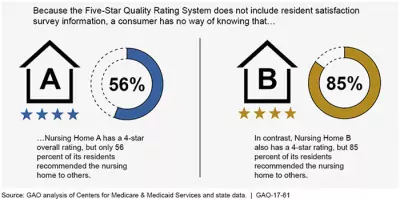Health Care Quality
Issue Summary
Despite high health care spending, there are still problems with the quality of the nation’s health care services. The cost and quality of health care services can vary significantly, with high cost not necessarily indicating high quality. As consumers pay for a growing proportion of their health care, they need better information on costs and quality so that they can make informed decisions.
The Department of Health and Human Services (HHS) is responsible for a number of efforts to enhance health care quality and the transparency of information for consumers. However, there are ways it could improve its efforts.
For instance:
- Quality measures. Federal health care programs and other health care payers are increasingly examining the quality of the services people receive—and adjusting payments accordingly. However, payers do not always agree on which quality measures to track, making it difficult to improve the quality of care and burdening doctors and other providers with having to report different data to different payers. While HHS is working to better align its health care quality measures across programs and private payers, it needs to systematically assess the quality measures it selects relative to its quality measurement strategic objectives.
- Medicaid managed care organizations. States increasingly contract with Medicaid managed care organizations to provide long-term services and supports for adults and children with different types of disabilities or conditions. These organizations make many of the decisions about the amounts and types of care that these Medicaid beneficiaries receive to assist them with basic needs like bathing or eating. However, 6 selected states had significant problems with care management through these contracts, and HHS oversight of quality and access for these organizations has been limited. HHS needs to assess the nature and prevalence of quality and access problems with Medicaid’s managed long-term care services and supports across states.
- Telehealth. The use of telehealth services increased during the COVID-19 pandemic under both Medicare and Medicaid. However, there have been concerns about the quality of care that patients receive through telehealth. The Centers for Medicare and Medicaid Services (CMS) has not comprehensively assessed the quality of telehealth services under Medicare. In addition, while steps have been taken to collect and analyze the quality of telehealth under Medicaid, CMS has not determined whether further quality assessments are warranted.
- Nursing homes. The COVID-19 pandemic brought into sharper focus problems with nursing home quality that have persisted for many years. For example, gaps in CMS’s oversight made it harder to protect nursing home residents from abuse. Further, infection prevention and control issues, such as failure to use proper hand hygiene, were the most common deficiencies cited by state surveyors in the years prior to the COVID-19 pandemic. Many of the same nursing homes were repeatedly cited for these issues year after year, indicating persistent quality of care problems.
- Hospices. Similarly, there have been concerns about the quality of care provided in hospices. As of May 2023, about 10% of hospices were overdue for an inspection survey. CMS should prioritize survey completion for overdue hospices based on potential risk factors, such as past quality issues Further, CMS could better protect hospice patients by requiring hospice providers to report all abuse and neglect allegations immediately.
- Care Compare website. CMS’s Care Compare, allows people to research and compare nursing homes and hospices, as well as other types of providers. CMS has worked to improve the transparency and information on the website. For example, CMS added an abuse icon for consumers to more easily identify nursing homes cited with abuse deficiencies. CMS also updated nursing home ownership to include information on facilities with common ownership. However, Care Compare still lacks some key information, such as consumer satisfaction scores and the ability to compare nursing homes across states. Additionally, the nursing home information on Care Compare is not always updated regularly—some of it is more than 2 years old. Further, Care Compare doesn’t have clear, prominent, and easily accessible data on hospices so that consumers can make informed choices.
Example of Missing Information Affecting a Consumer's Nursing Home Decision
Image


